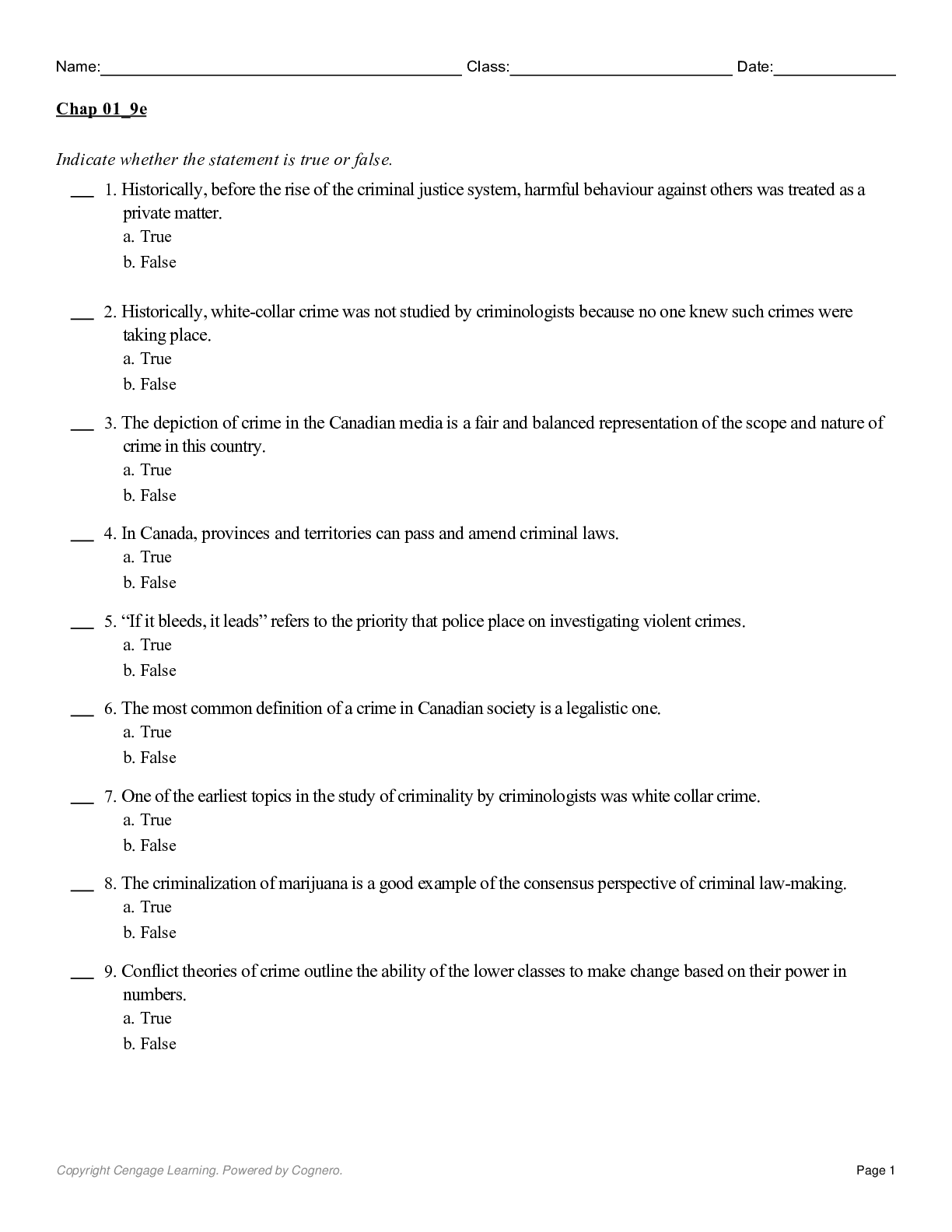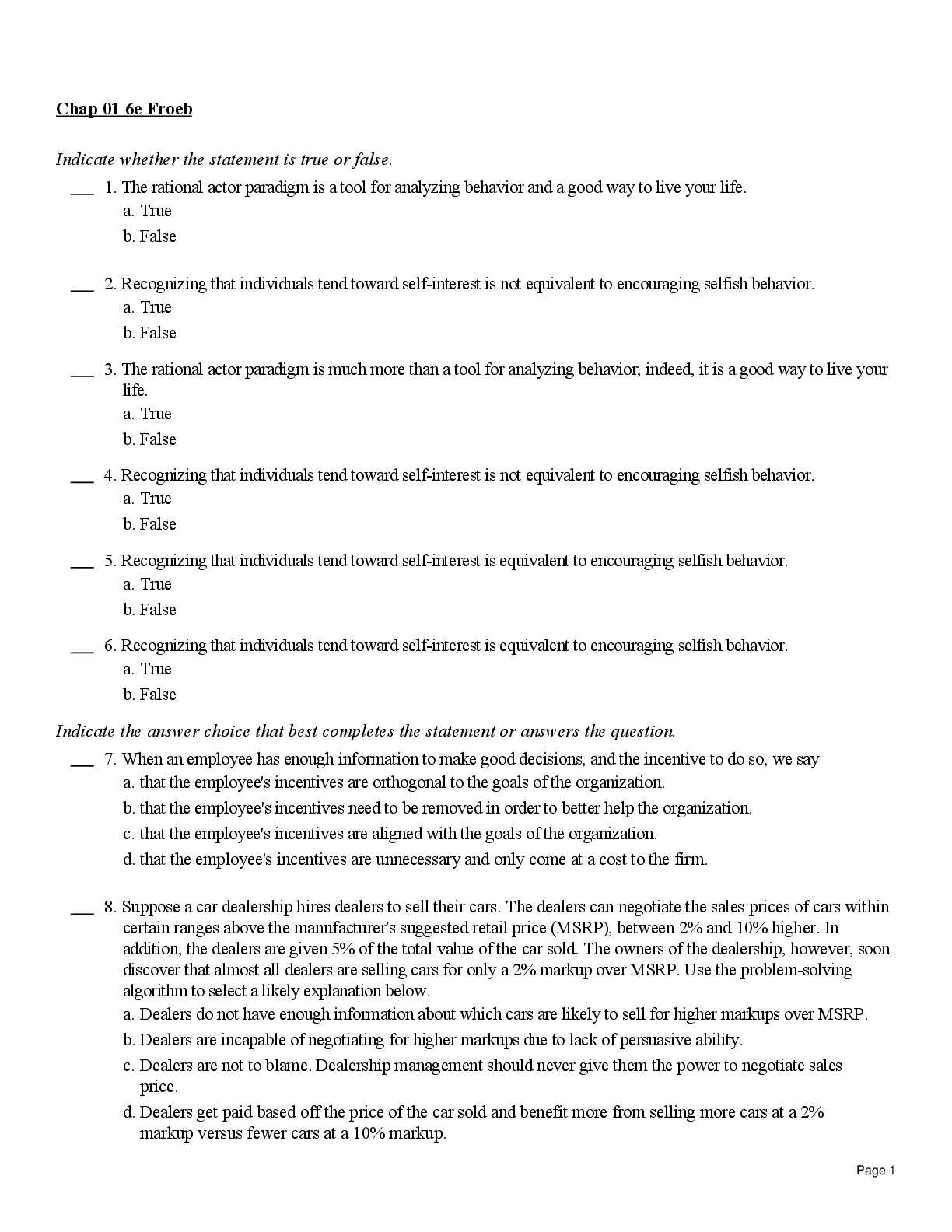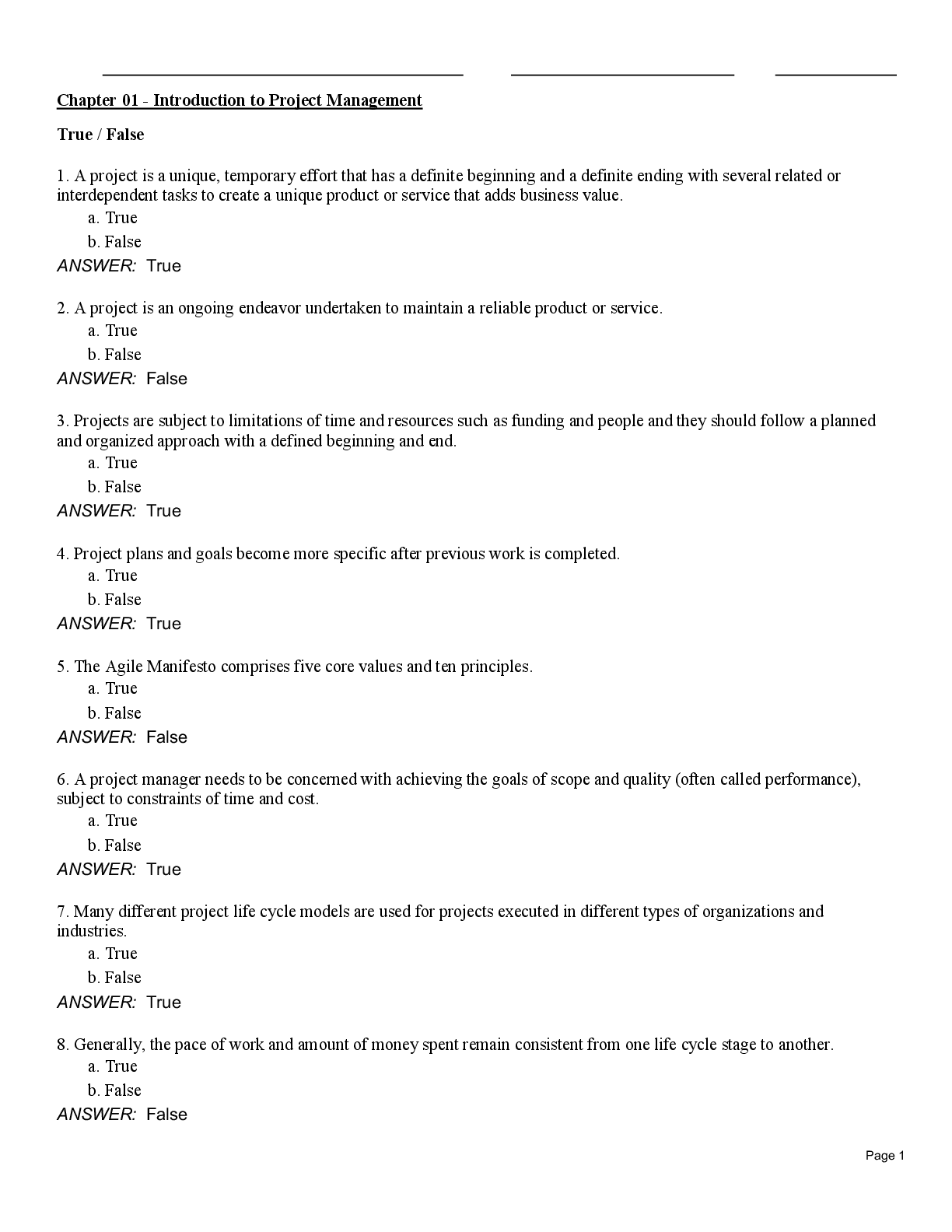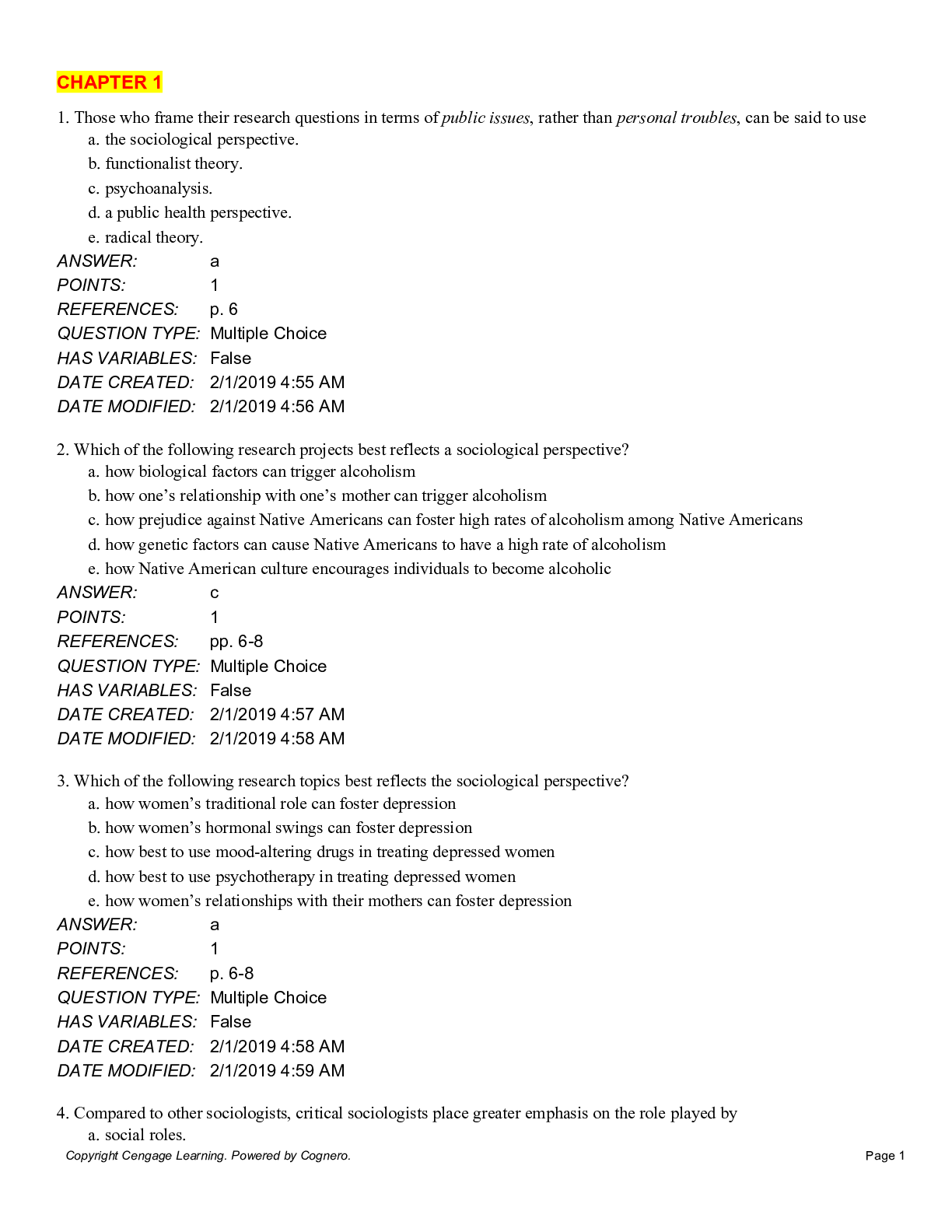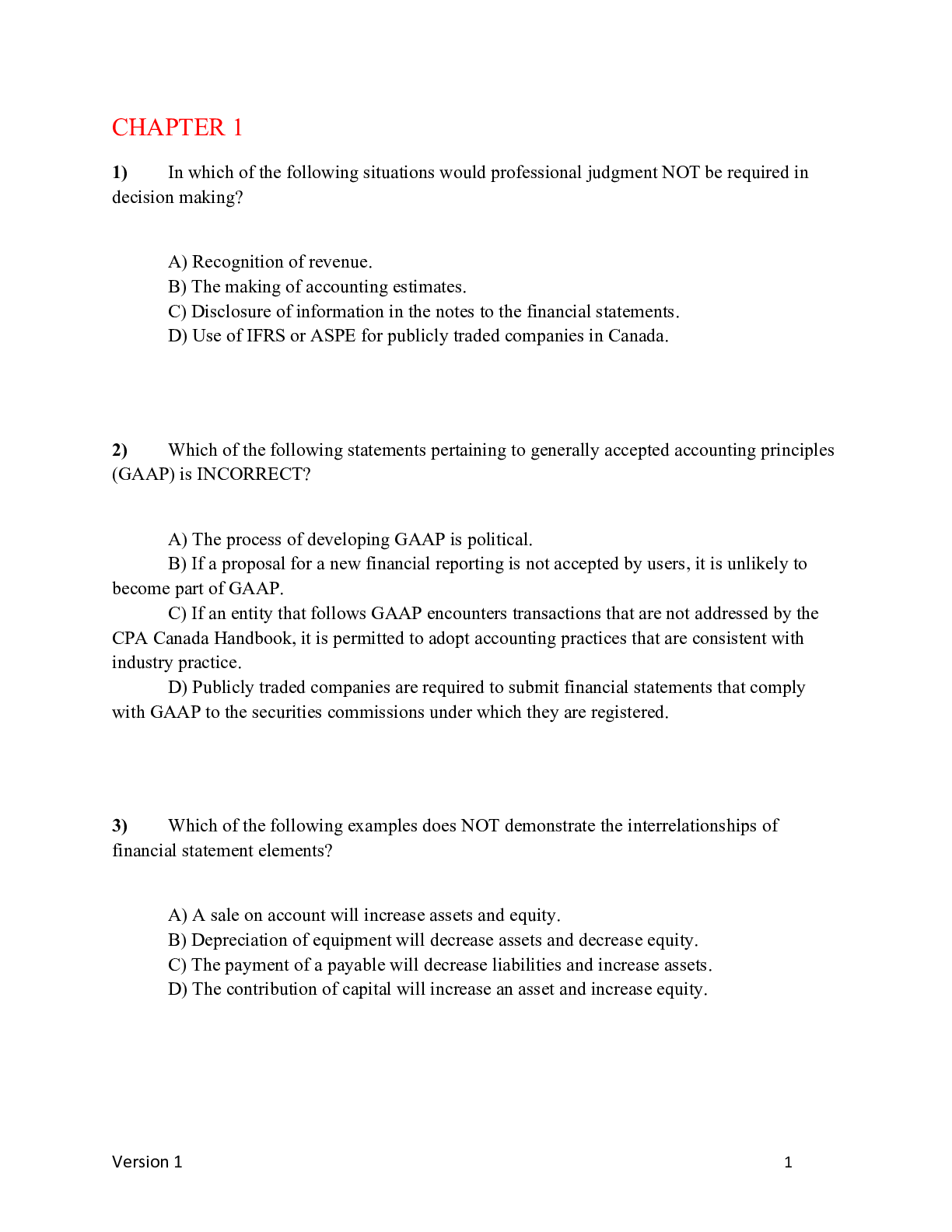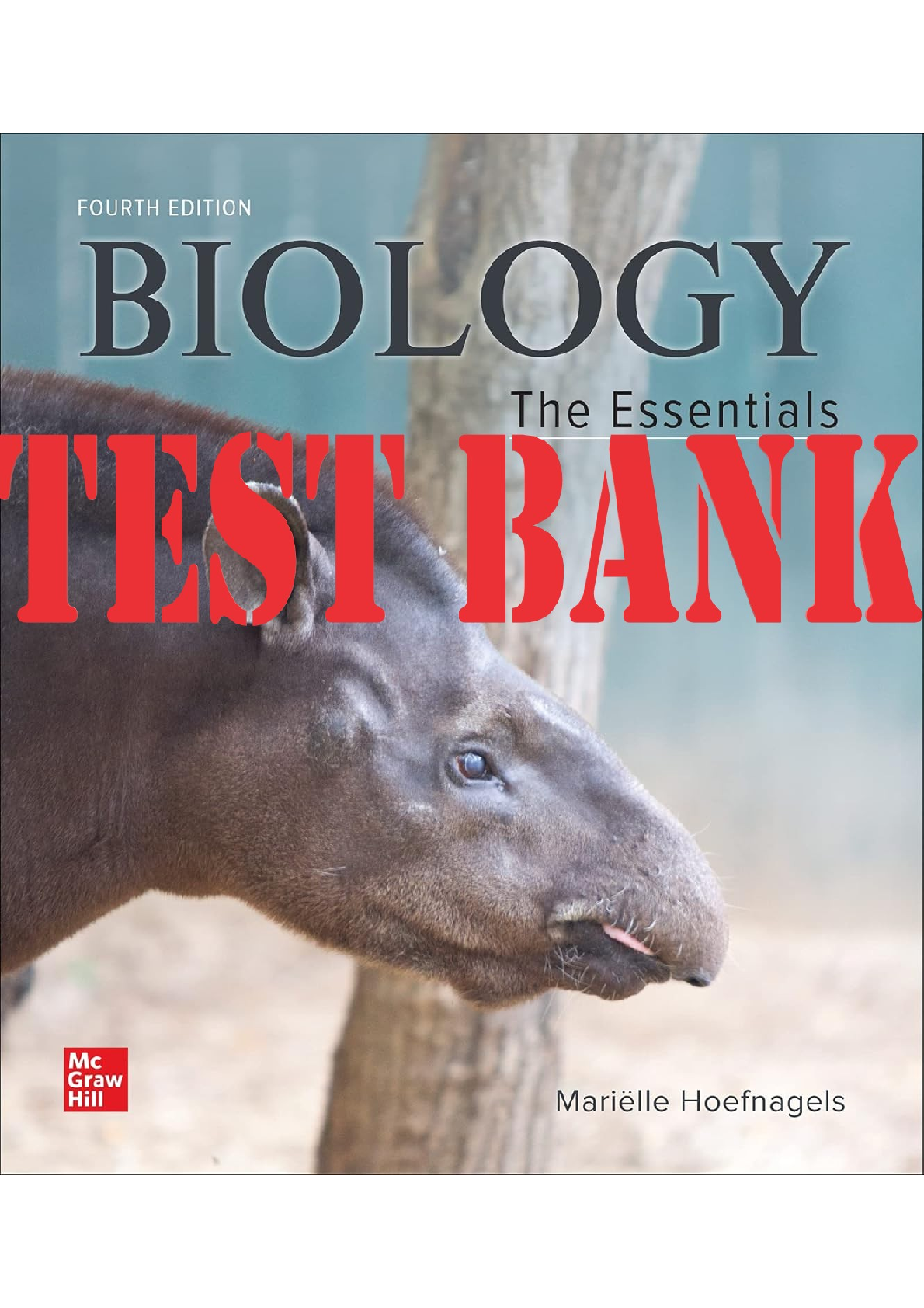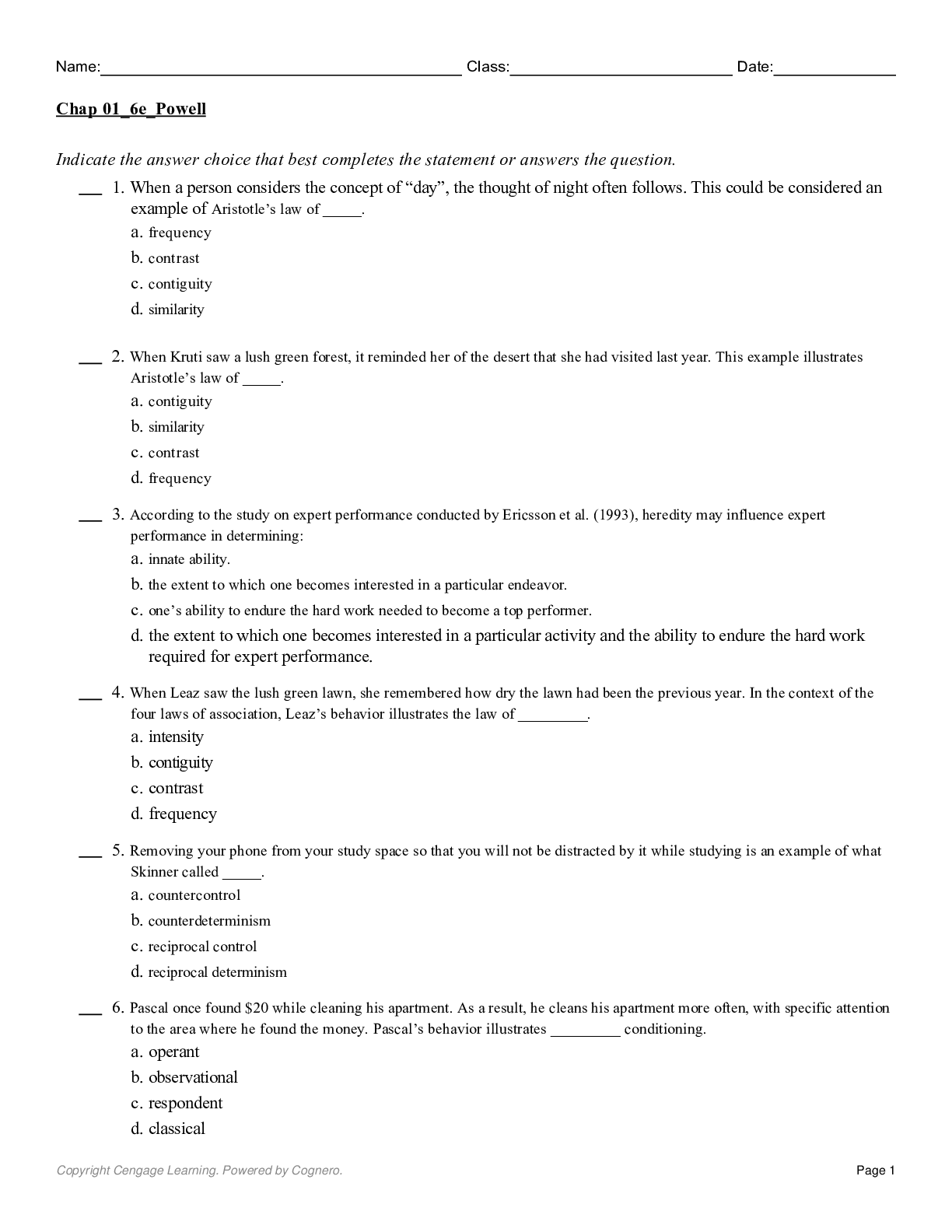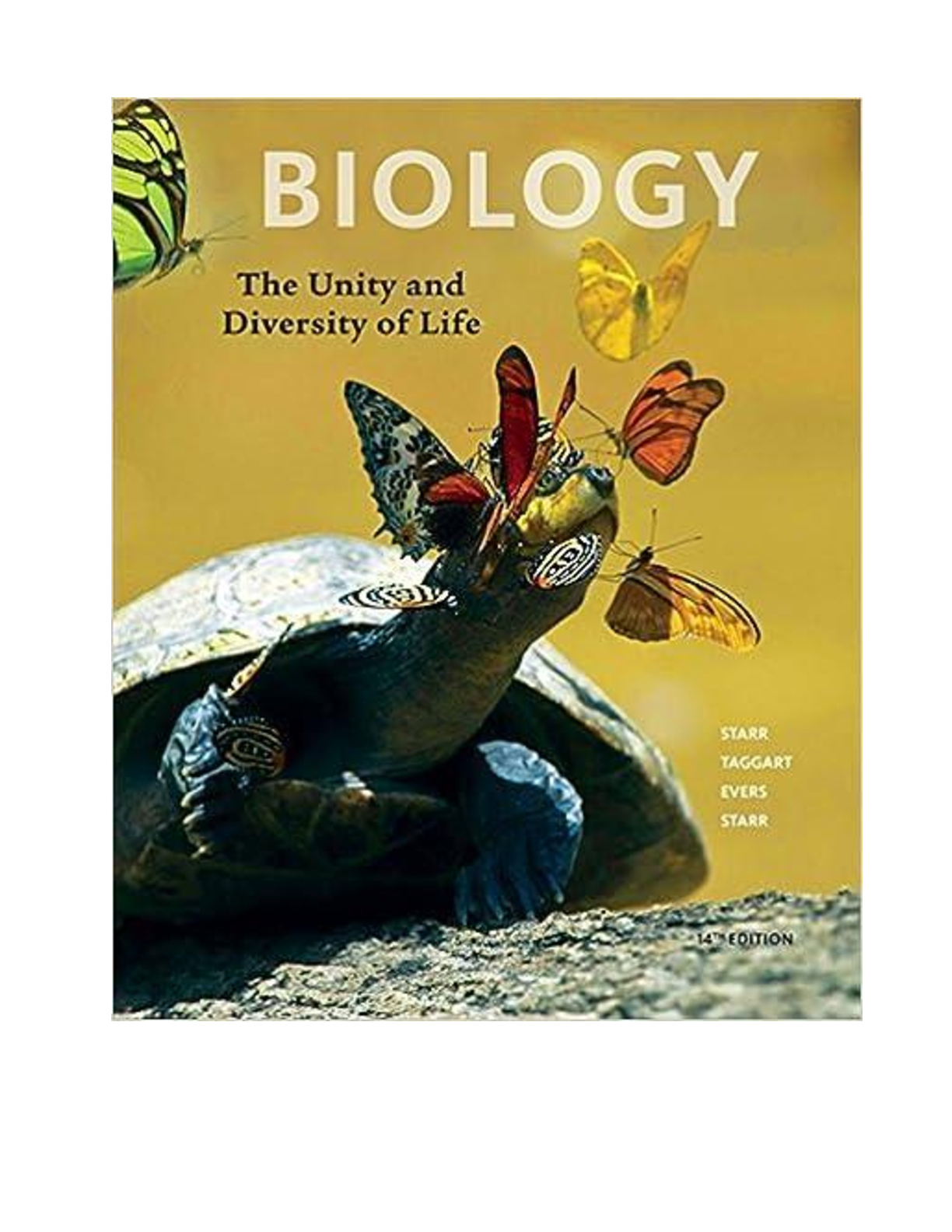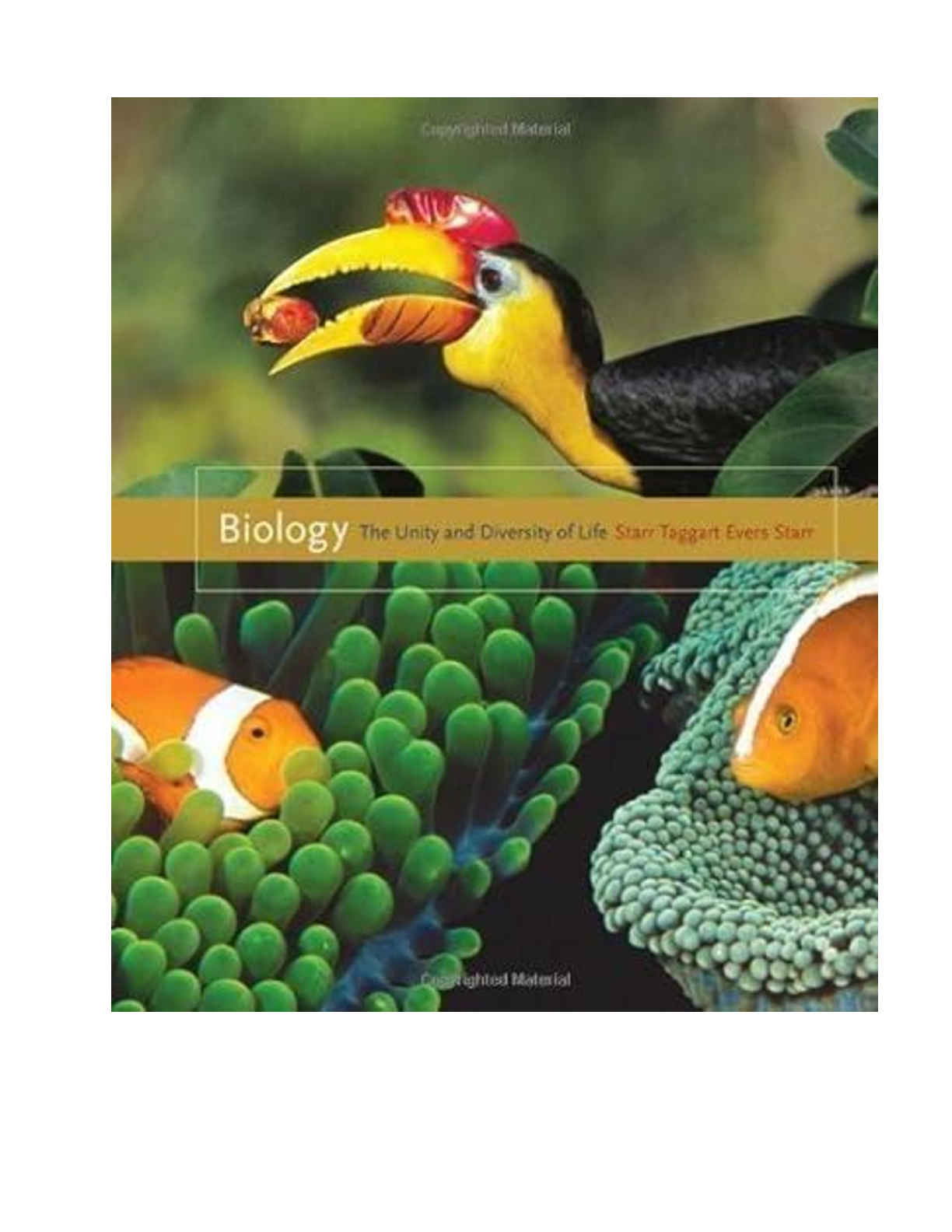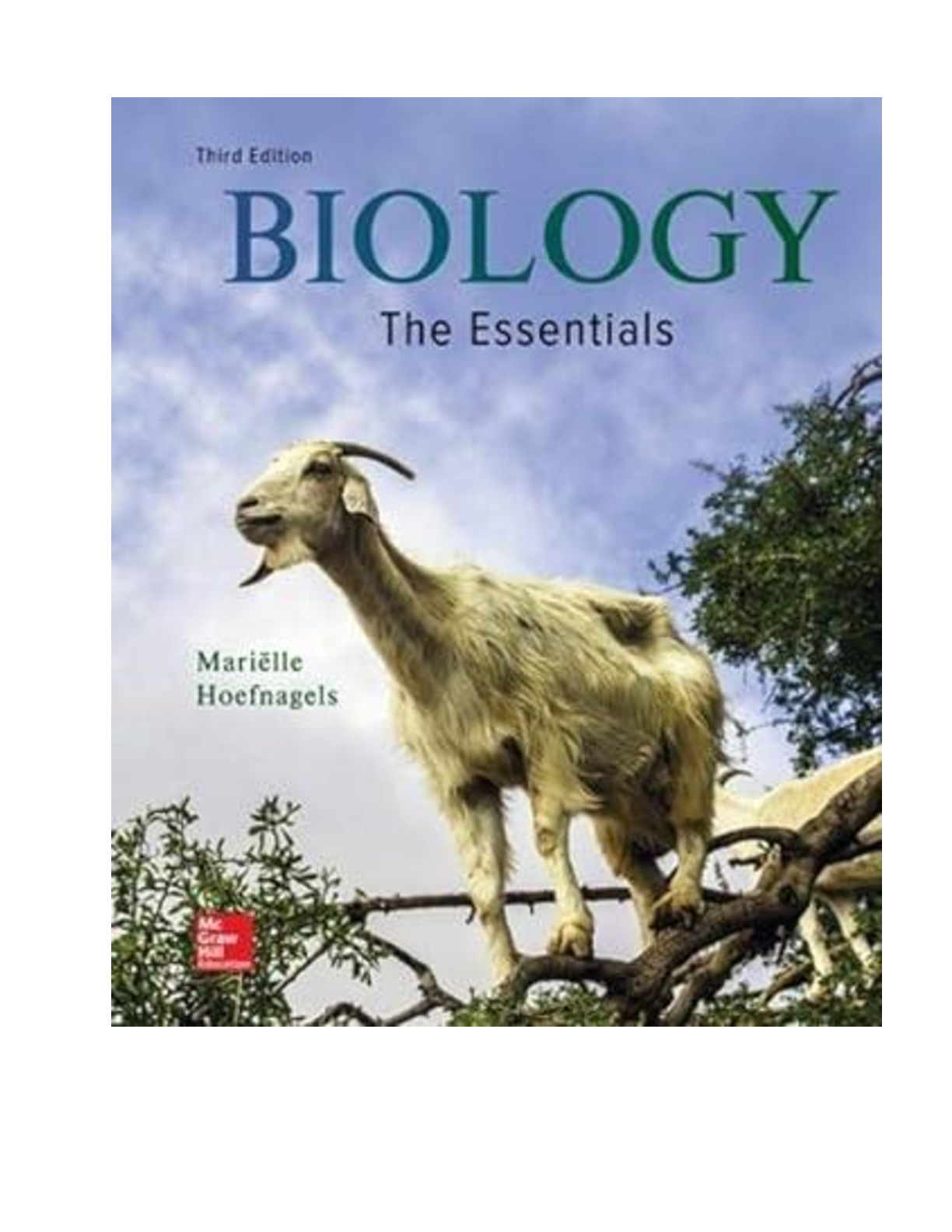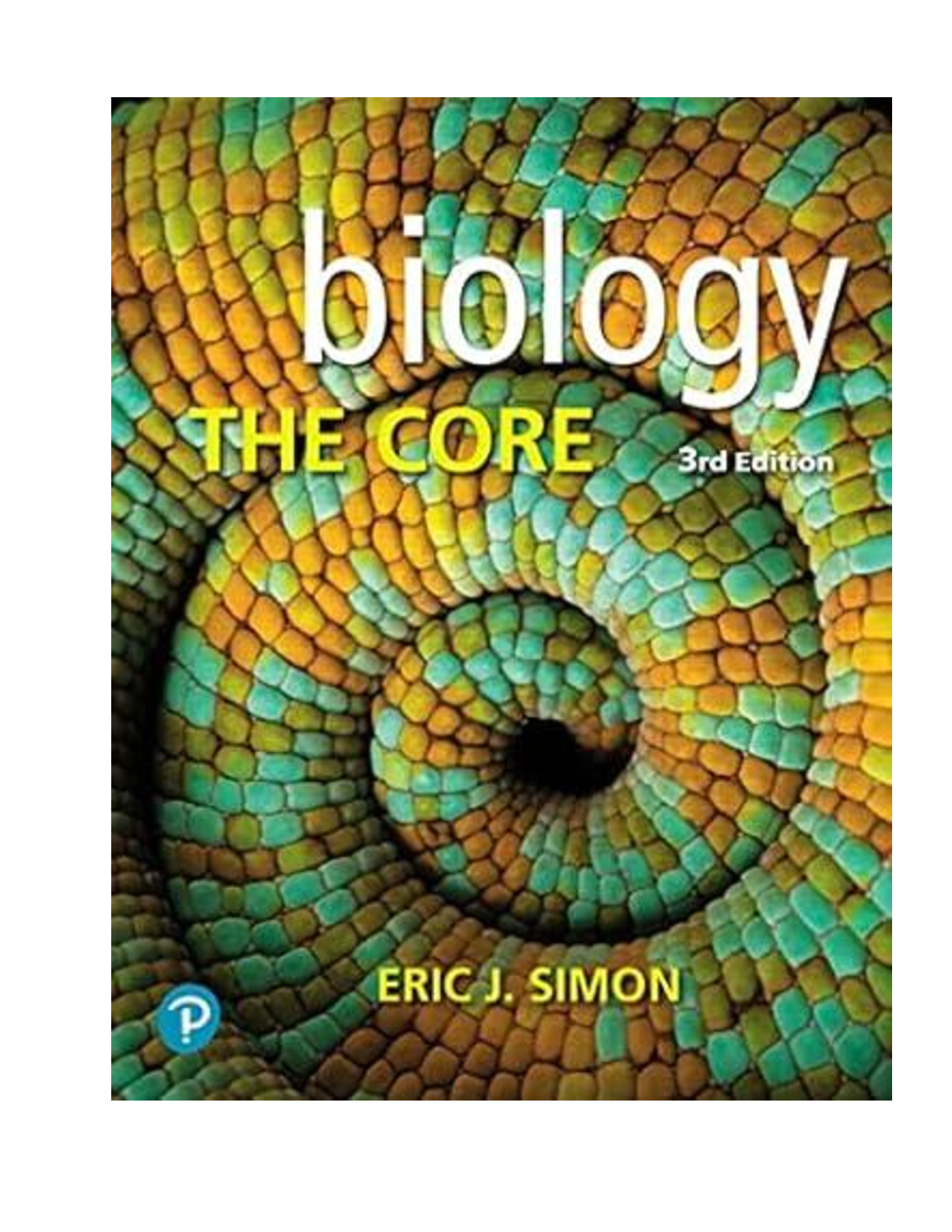Biology > TEST BANKS > Test Bank for Biology The Dynamic Science, 5th Edition by Russell (All)
Test Bank for Biology The Dynamic Science, 5th Edition by Russell
Document Content and Description Below
Test Bank for Biology The Dynamic Science, 5th Edition, 5e by Peter J. Russell, Paul E. Hertz, Beverly McMillan TEST BANK ISBN-13: 9780357134894 Full chapters included Chapter 1: Introduction to ... Biological Concepts and Research 1.1 What Is Life? Characteristics of Living Organisms 1.2 Biological Evolution 1.3 Biodiversity and the Tree of Life 1.4 Biological Research Review Key Concepts Test Your Knowledge Interpret the Data Chapter 2: Life, Chemistry, and Water 2.1 The Organization of Matter: Elements and Atoms 2.2 Atomic Structure 2.3 Chemical Bonds and Chemical Reactions 2.4 Hydrogen Bonds and the Properties of Water 2.5 Water Ionization and Acids, Bases, and Buffers Review Key Concepts Test Your Knowledge Interpret the Data Chapter 3: Biological Molecules: The Carbon Compounds of Life 3.1 Formation and Modification of Biological Molecules 3.2 Carbohydrates 3.3 Lipids 3.4 Proteins 3.5 Nucleotides and Nucleic Acids Review Key Concepts Test Your Knowledge Interpret the Data Chapter 4: Cells 4.1 Basic Features of Cell Structure and Function 4.2 Prokaryotic Cells 4.3 Eukaryotic Cells 4.4 Specialized Structures of Plant Cells 4.5 The Animal Cell Surface Review Key Concepts Test Your Knowledge Interpret the Data Chapter 5: Membranes and Transport 5.1 Membrane Structure and Function 5.2 Functions of Membranes in Transport: Passive Transport 5.3 Passive Water Transport and Osmosis 5.4 Active Transport 5.5 Exocytosis and Endocytosis Review Key Concepts Test Your Knowledge Interpret the Data Chapter 6: Energy, Enzymes, and Biological Reactions 6.1 Energy, Life, and the Laws of Thermodynamics 6.2 Free Energy and Spontaneous Reactions 6.3 Adenosine Triphosphate (ATP): The Energy Currency of the Cell 6.4 Role of Enzymes in Biological Reactions 6.5 Factors That Affect Enzyme Activity 6.6 RNA-Based Biological Catalysts: Ribozymes Review Key Concepts Test Your Knowledge Interpret the Data Chapter 7: Cellular Respiration: Harvesting Chemical Energy 7.1 Overview of Cellular Respiration 7.2 Glycolysis: Splitting the Sugar in Half 7.3 Pyruvate Oxidation and the Citric Acid Cycle 7.4 Oxidative Phosphorylation: The Electron Transport Chain and Chemiosmosis 7.5 Fermentation 7.6 Interrelationships of Catabolic and Anabolic Pathways Review Key Concepts Test Your Knowledge Interpret the Data Chapter 8: Photosynthesis 8.1 Photosynthesis: An Overview 8.2 The Light-Dependent Reactions of Photosynthesis 8.3 The Light-Independent Reactions of Photosynthesis 8.4 Photorespiration and Alternative Processes of Carbon Fixation 8.5 Photosynthesis and Cellular Respiration Compared Review Key Concepts Test Your Knowledge Interpret the Data Chapter 9: Cell Communication 9.1 Cell Communication: An Overview 9.2 Signaling Pathways Using Surface Receptors 9.3 Signaling Pathways Using Internal Receptors 9.4 Integration of Cell Communication Pathways Review Key Concepts Test Your Knowledge Interpret the Data Chapter 10: Cell Division and Mitosis 10.1 The Cycle of Cell Growth and Division: An Overview 10.2 The Mitotic Cell Cycle 10.3 Cell Cycle Regulation 10.4 Cell Division in Bacteria Review Key Concepts Test Your Knowledge Interpret the Data Chapter 11: Meiosis: The Cellular Basis of Sexual Reproduction 11.1 The Mechanisms of Meiosis 11.2 Mechanisms That Generate Genetic Variability 11.3 The Time and Place of Meiosis in Organismal Life Cycles Review Key Concepts Test Your Knowledge Interpret the Data Chapter 12: Mendel, Genes, and Inheritance 12.1 The Beginnings of Genetics: Mendel's Garden Peas 12.2 Later Modifications and Additions to Mendel's Principles Review Key Concepts Test Your Knowledge Interpret the Data Chapter 13: Genes, Chromosomes, and Human Genetics 13.1 Genetic Linkage and Recombination 13.2 Sex-Linked Genes 13.3 Chromosomal Mutations That Affect Inheritance 13.4 Human Genetic Traits, Pedigree Analysis, and Genetic Counseling 13.5 Non-Mendelian Patterns of Inheritance Review Key Concepts Test Your Knowledge Interpret the Data Chapter 14: DNA Structure and Replication 14.1 Establishing DNA as the Hereditary Molecule 14.2 DNA Structure 14.3 DNA Replication 14.4 Repair of Errors in DNA Review Key Concepts Test Your Knowledge Interpret the Data Chapter 15: Gene Expression: From DNA to Protein 15.1 The Connection between DNA, RNA, and Protein 15.2 Transcription: DNA-Directed RNA Synthesis 15.3 Production of mRNAs in Eukaryotes 15.4 Translation: mRNA-Directed Polypeptide Synthesis 15.5 Genetic Changes That Affect Protein Structure and Function Review Key Concepts Test Your Knowledge Interpret the Data Chapter 16: Regulation of Gene Expression 16.1 Transcriptional Regulation of Gene Expression in Bacteria 16.2 Transcriptional Regulation of Gene Expression in Eukaryotes 16.3 Posttranscriptional Regulation of Gene Expression in Eukaryotes 16.4 Genetic and Molecular Regulation of Development 16.5 The Genetics and Genomics of Cancer Review Key Concepts Test Your Knowledge Interpret the Data Chapter 17: Bacterial and Viral Genetics 17.1 Gene Transfer and Genetic Recombination in Bacteria 17.2 Viruses and Viral Genetics 17.3 Viroids and Prions, Infectious Agents Lacking Protein Coats Review Key Concepts Test Your Knowledge Interpret the Data Chapter 18: DNA Technology: Making and Using Genetically Altered Organisms, and Other Applications 18.1 Making Genetically Altered Organisms Using Gene Cloning 18.2 Making Genetically Altered Cells and Organisms by Genome Editing 18.3 Applications of Genetically Altered Cells and Organisms 18.4 Other Applications of DNA Technology Review Key Concepts Test Your Knowledge Interpret the Data Chapter 19: Genomes and Proteomes 19.1 Genomics: An Overview 19.2 Sequencing and Annotating Genomes 19.3 Genome Landscapes 19.4 Determining the Functions of Genes 19.5 Genome Evolution Review Key Concepts Test Your Knowledge Interpret the Data Chapter 20: Development of Evolutionary Thinking 20.1 Recognition of Evolutionary Change 20.2 Darwin's Journeys 20.3 Evolutionary Biology since Darwin Review Key Concepts Test Your Knowledge Interpret the Data Chapter 21: Microevolution: Genetic Changes within Populations 21.1 Variation in Natural Populations 21.2 Population Genetics 21.3 The Agents of Microevolution 21.4 Maintaining Genetic and Phenotypic Variation 21.5 Adaptation and Evolutionary Constraints Review Key Concepts Test Your Knowledge Interpret the Data Chapter 22: Speciation 22.1 What Is a Species? 22.2 Maintaining Reproductive Isolation 22.3 The Geography of Speciation 22.4 Genetic Mechanisms of Speciation Review Key Concepts Test Your Knowledge Interpret the Data Chapter 23: Paleobiology and Macroevolution 23.1 The Fossil Record 23.2 Earth History 23.3 Historical Biogeography and Convergent Biotas 23.4 The History of Biodiversity 23.5 Interpreting Evolutionary Lineages 23.6 The Evolution of Morphological Novelties Review Key Concepts Test Your Knowledge Interpret the Data Chapter 24: Systematics and Phylogenetics: Revealing the Tree of Life 24.1 Nomenclature and Classification 24.2 Phylogenetic Trees 24.3 Sources of Data for Phylogenetic Analyses 24.4 Traditional Classification and Paraphyletic Groups 24.5 The Cladistic Revolution 24.6 Phylogenetic Trees as Research Tools 24.7 Molecular Phylogenetic Analyses Review Key Concepts Test Your Knowledge Interpret the Data Chapter 25: The Origin of Life 25.1 The Formation of Molecules Necessary for Life 25.2 The Origin of Cells 25.3 The Three Domains of Life Review Key Concepts Test Your Knowledge Interpret the Data Chapter 26: Bacteria and Archaea: The Primary Domains 26.1 Prokaryotic Structure and Function 26.2 The Domain Bacteria 26.3 The Domain Archaea Review Key Concepts Test Your Knowledge Interpret the Data Chatper 27: Eukaryotes: Two Domains United 27.1 The Diversity of Eukaryotes 27.2 Amorphea 27.3 Archaeplastida 27.4 The SAR Supergroup 27.5 Excavata Review Key Concepts Test Your Knowledge Interpret the Data Chapter 28: Seedless Plants 28.1 Plant Evolution: Adaptations to Life on Land 28.2 Bryophytes, the Nonvascular Land Plants 28.3 Seedless Vascular Plants 28.4 Ecological, Economic, and Research Importance of Seedless Plants Review Key Concepts Test Your Knowledge Interpret the Data Chapter 29: Seed Plants 29.1 The Rise of Seed Plants 29.2 Gymnosperms: The "Naked Seed" Plants 29.3 Angiosperms: Flowering Plants 29.4 Seed Plants and People: Food, Shelter, Fibers, Medicines, and Research Review Key Concepts Test Your Knowledge Interpret the Data Chapter 30: Fungi 30.1 General Characteristics of Fungi 30.2 Evolution of the Kingdom Fungi 30.3 Fungal Associations: Lichens and Mycorrhizae 30.4 Impacts of Fungi in Ecosystems and Society Review Key Concepts Test Your Knowledge Interpret the Data Chapter 31: Animal Phylogeny, Acoelomates, and Protostomes 31.1 What Is an Animal? 31.2 Key Innovations in Animal Evolution 31.3 An Overview of Animal Phylogeny and Classification 31.4 Animals without Tissues: Parazoa 31.5 Eumetazoans with Radial Symmetry 31.6 Lophotrochozoan Protostomes 31.7 Ecdysozoan Protostomes Review Key Concepts Test Your Knowledge Interpret the Data Chapter 32: Deuterostomes: Vertebrates and Their Closest Relatives 32.1 Invertebrate Deuterostomes 32.2 Overview of the Phylum Chordata 32.3 The Origin and Diversification of Vertebrates 32.4 "Agnathans": Hagfishes and Lampreys, Conodonts and Ostracoderms 32.5 Gnathostomata: The Evolution of Jaws 32.6 Tetrapoda: The Evolution of Limbs 32.7 Amniota: The Evolution of Fully Terrestrial Vertebrates 32.8 Living Lepidosaurs: Sphenodontids and Squamates 32.9 Living Archelosaurs: Turtles, Crocodilians, and Birds 32.10 Mammalia: Monotremes, Marsupials, and Placentals 32.11 Nonhuman Primates 32.12 The Evolution of Humans Review Key Concepts Test Your Knowledge Interpret the Data Chapter 33: The Plant Body 33.1 Basic Concepts of Plant Structure and Growth 33.2 The Three Plant Tissue Systems 33.3 Root Systems 33.4 Primary Shoot Systems 33.5 Secondary Growth Review Key Concepts Test Your Knowledge Interpret the Data Chapter 34: Transport in Plants 34.1 Overview of Water and Solute Movements in Plants 34.2 Roots: Moving Water and Minerals into the Plant 34.3 Transport of Water and Minerals in the Xylem 34.4 Stomata: Regulating the Loss of Water by Transpiration 34.5 Transport of Organic Substances in the Phloem Review Key Concepts Test Your Knowledge Interpret the Data Chapter 35: Plant Nutrition 35.1 Plant Nutritional Requirements 35.2 Soil 35.3 Root Adaptations for Obtaining and Absorbing Nutrients Review Key Concepts Test Your Knowledge Interpret the Data Chapter 36: Reproduction and Development in Flowering Plants 36.1 Overview of Flowering Plant Reproduction 36.2 The Formation of Flowers and Gametes 36.3 Pollination, Fertilization, and Germination 36.4 Asexual Reproduction of Flowering Plants 36.5 Early Plant Development Review Key Concepts Test Your Knowledge Interpret the Data Chapter 37: Plant Signals and Responses to the Environment 37.1 Introduction to Plant Hormones 37.2 Plant Chemical Defenses 37.3 Plant Movements 37.4 Plant Biological Clocks Review Key Concepts Test Your Knowledge Interpret the Data Chapter 38: Introduction to Animal Organization and Physiology 38.1 Organization of the Animal Body 38.2 Animal Tissues 38.3 Coordination of Tissues in Organs and Organ Systems 38.4 Homeostasis Review Key Concepts Test Your Knowledge Interpret the Data Chapter 39: Neurons and Synapses 39.1 Neuron Structure and Function 39.2 Signaling by Neurons 39.3 Transmission across Chemical Synapses 39.4 Signal Integration in Neurons Review Key Concepts Test Your Knowledge Interpret the Data Chapter 40: Nervous Systems 40.1 Organizing Neurons into Systems 40.2 The Peripheral Nervous System (PNS) 40.3 The Central Nervous System (CNS) 40.4 Memory and Consciousness Review Key Concepts Test Your Knowledge Interpret the Data Chapter 41: Sensory Systems 41.1 Overview of Sensation 41.2 Mechanosensation and Touch 41.3 Mechanosensation and Hearing 41.4 Photoreceptors and Vision 41.5 The Chemical Senses: Smell and Taste 41.6 Sensing Temperature and Electromagnetic Fields 41.7 Pain Review Key Concepts Test Your Knowledge Interpret the Data Chapter 42: The Endocrine System 42.1 Hormones and Their Secretion 42.2 Mechanisms of Hormone Action 42.3 The Hypothalamus and Pituitary 42.4 Other Major Endocrine Glands of Vertebrates 42.5 Endocrine Systems in Invertebrates Review Key Concepts Test Your Knowledge Interpret the Data Chapter 43: Muscles, Bones, and Body Movements 43.1 Vertebrate Skeletal Muscle: Structure and Function 43.2 Skeletal Systems 43.3 Vertebrate Movement: The Interactions between Muscles and Bones Review Key Concepts Test Your Knowledge Interpret the Data Chapter 44: The Circulatory System 44.1 Animal Circulatory Systems: An Introduction 44.2 Blood and Its Components 44.3 The Heart 44.4 Blood Vessels of the Circulatory System 44.5 Maintaining Blood Flow and Pressure 44.6 The Lymphatic System Review Key Concepts Test Your Knowledge Interpret the Data Chapter 45: Defenses against Disease 45.1 Innate Immunity: Nonspecific Defenses 45.2 Adaptive Immunity: Specific Defenses 45.3 Malfunctions and Failures of the Immune System 45.4 Evolved Defenses against Pathogens in Other Animals Review Key Concepts Test Your Knowledge Interpret the Data Chapter 46: The Respiratory System 46.1 The Principles of Gas Exchange 46.2 Evolutionary Adaptations for Respiration 46.3 The Mammalian Respiratory System 46.4 Mechanisms of Gas Exchange and Transport 46.5 Respiration at High Altitudes and in Ocean Depths Review Key Concepts Test Your Knowledge Interpret the Data Chapter 47: Digestive Systems and Animal Nutrition 47.1 Feeding and Nutrition 47.2 Digestive Processes 47.3 Digestion in Humans and Other Mammals 47.4 Regulation of Digestion and Food Intake 47.5 Digestive Specializations in Vertebrates Review Key Concepts Test Your Knowledge Interpret the Data Chapter 48: Regulating the Internal Enviromment: Osmoregulation, Excretion, and Thermoregulation 48.1 Introduction to Osmoregulation and Excretion 48.2 Osmoregulation and Excretion in Invertebrates 48.3 Osmoregulation and Excretion in Mammals 48.4 Regulation of Mammalian Kidney Function 48.5 Kidney Function in Nonmammalian Vertebrates 48.6 Introduction to Thermoregulation 48.7 Ectothermy 48.8 Endothermy Review Key Concepts Test Your Knowledge Interpret the Data Chapter 49: Animal Reproduction 49.1 Animal Reproductive Modes: Asexual and Sexual Reproduction 49.2 Cellular Mechanisms of Sexual Reproduction 49.3 Sexual Reproduction in Humans 49.4 Methods for Preventing Pregnancy: Contraception Review Key Concepts Test Your Knowledge Interpret the Data Chapter 50: Animal Development 50.1 Mechanisms of Embryonic Development 50.2 Major Patterns of Cleavage and Gastrulation 50.3 From Gastrulation to Adult Body Structures: Organogenesis 50.4 Embryonic Development of Humans and Other Mammals 50.5 The Cellular Basis of Development Review Key Concepts Test Your Knowledge Interpret the Data Chapter 51: Ecology and the Biosphere 51.1 The Science of Ecology 51.2 Environmental Diversity of the Biosphere 51.3 Organismal Responses to Environmental Variation and Climate Change 51.4 Terrestrial Biomes 51.5 Freshwater Environments 51.6 Marine Environments Review Key Concepts Test Your Knowledge Interpret the Data Chapter 52: Population Ecology 52.1 Population Characteristics 52.2 Demography 52.3 The Evolution of Life Histories 52.4 Models of Population Growth 52.5 Population Dynamics 52.6 Human Population Growth Review Key Concepts Test Your Knowledge Interpret the Data Chapter 53: Population Interactions and Community Ecology 53.1 Population Interactions 53.2 The Nature of Ecological Communities 53.3 Community Characteristics 53.4 Effects of Population Interactions on Community Characteristics 53.5 Effects of Disturbance on Community Characteristics 53.6 Ecological Succession: Responses to Disturbance 53.7 Variations in Species Richness among Communities Review Key Concepts Test Your Knowledge Interpret the Data Chapter 54: Ecosystems and Global Change 54.1 Modeling Ecosystem Processes 54.2 Energy Flow and Ecosystem Energetics 54.3 Nutrient Cycling in Ecosystems 54.4 Human Activities and Anthropogenic Global Change Review Key Concepts Test Your Knowledge Interpret the Data Chapter 55: Biodiversity and Conservation Biology 55.1 The Biodiversity Crisis on Land, in the Sea, and in River Systems 55.2 Specific Threats to Biodiversity 55.3 Ecosystem Services That Biodiversity Provides 55.4 Which Species and Ecosystems Are Most Threatened by Human Activities? 55.5 Conservation Biology: Principles and Theory 55.6 Conservation Biology: Practical Strategies and Economic Tools Review Key Concepts Test Your Knowledge Interpret the Data Chapter 56: Animal Behavior 56.1 Instinctive and Learned Behaviors 56.2 Neurophysiological and Endocrine Control of Behavior 56.3 Migration and Wayfinding 56.4 Habitat Selection and Territoriality 56.5 The Evolution of Communication 56.6 The Evolution of Reproductive Behavior and Mating Systems 56.7 The Evolution of Social Behavior [Show More]
Last updated: 2 months ago
Preview 12 out of 1242 pages

Loading document previews ...
Buy this document to get the full access instantly
Instant Download Access after purchase
Buy NowInstant download
We Accept:

Reviews( 0 )
$26.00
Can't find what you want? Try our AI powered Search
Document information
Connected school, study & course
About the document
Uploaded On
Aug 16, 2022
Number of pages
1242
Written in
Additional information
This document has been written for:
Uploaded
Aug 16, 2022
Downloads
0
Views
133

